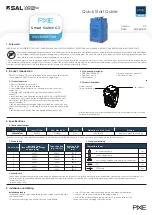
Relay Types
The modules supported by the BIT-2100 Series Switch System all provide high RF bandwidth, but
other than that differ in various ways:
•
each relay has two to eight terminals, of which one a time can be connected to a common
terminal
◦
terminology: e.g. a relay with two terminals (plus the common terminal) is indicated as
“2:1”
◦
the “path” indicates which terminal (a number starting at 1) is currently connected to
the common terminal
•
some relays support an additional path (denoted as path 0), which is when all terminals at
the same time are disconnected from the common terminal
•
the terminals which are currently not connected to the common terminal are either
terminated or unterminated (see also page 8)
•
most relays are latching, i.e. retain their path after power is turned off, while some fall back
into a default path (also known as “fail-safe”)
•
some modules contain a single relay, some modules contain up to six independent relays
What’s New
The most important changes of the BIT-2100B over the BIT-2100A are:
•
improved mainframe: display to show IP address, user controls at the front, data
connections on the rear, larger chassis so lab equipment can be put on top
•
new module types: terminated 8:1, unterminated 8:1, terminated 2:1
•
smart modules: data such as relay serial numbers and switch cycle counters can be queried
•
new software platform: the same reliable platform as in the BitifEye BIT-3000 DSGA
•
new USB functionality: using USB-VCM instead of USB-TMC, which allows to connect two
frames into a master-slave configuration
BIT-2100B User Manual
9










































